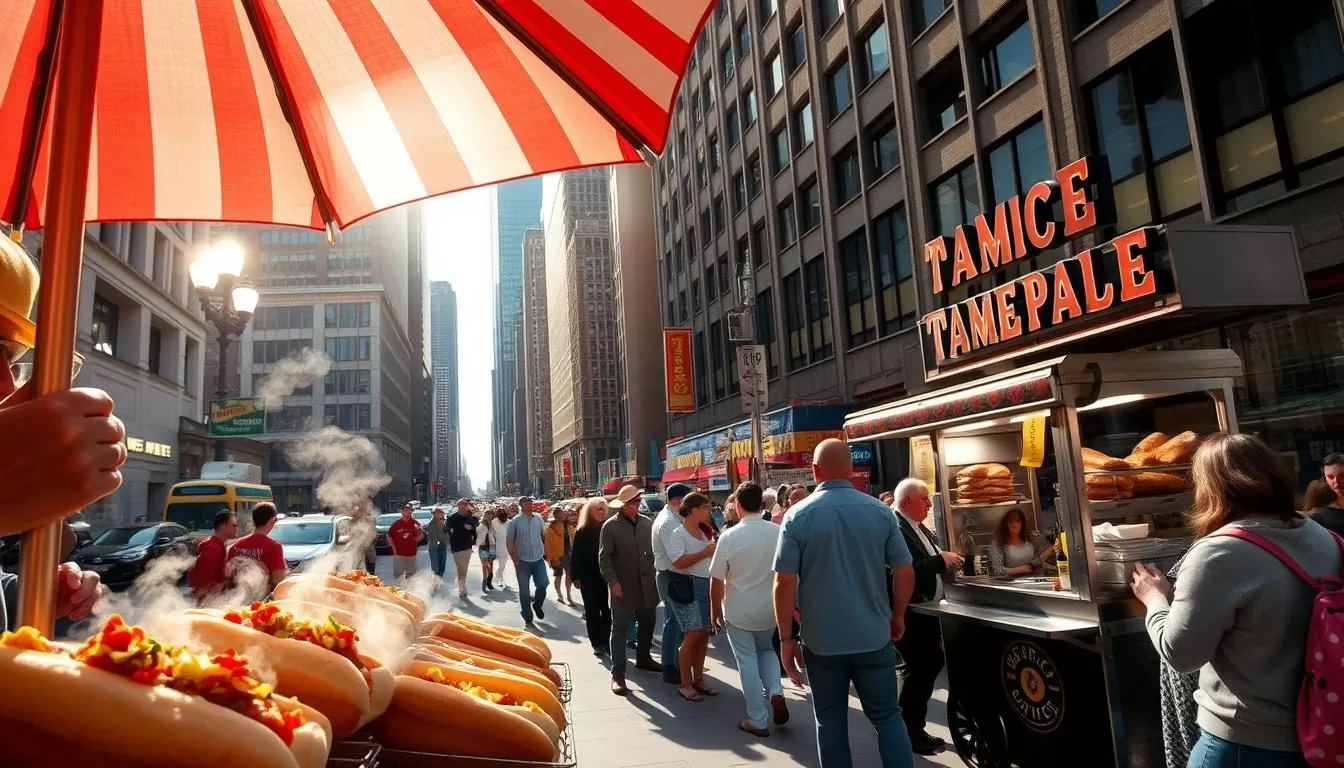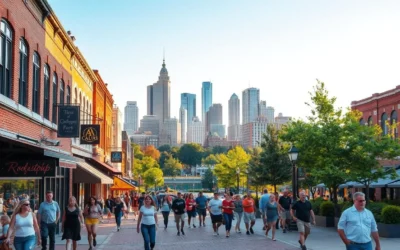✓ Accommodations✓ Flights✓ Rental Cars✓ Tours & Activities ✓ Tours & Activities
Chicago has earned a reputation as one of the nation’s top culinary capitals, and for good reason. The city’s rich history is deeply intertwined with its food culture, shaped by the diverse traditions of its immigrants.
As you explore the city’s vibrant street food scene, you’ll uncover a tapestry of flavors that reflect Chicago’s heritage. From iconic dishes to neighborhood specialties, the city’s culinary landscape is a testament to its cultural diversity.
You’re about to embark on a journey through 17 essential street food experiences that will take you through the heart of Chicago’s culinary identity. With insider tips on where to find the most authentic versions of each dish, you’ll be able to navigate the city’s diverse food landscape like a local.
The Rich Culinary Heritage of Chicago
As you explore Chicago, you’ll discover that its culinary heritage is as diverse as its population. The city’s food scene is a reflection of its history, shaped by the influx of immigrants from various parts of the world. This diversity has contributed to Chicago being renowned for its vibrant food culture, making it a paradise for food enthusiasts.
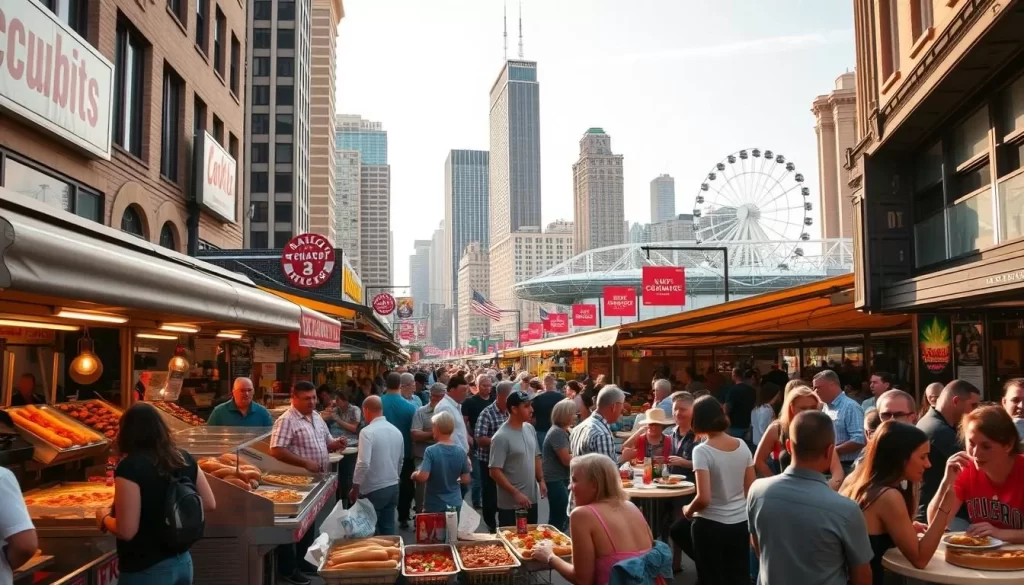
How Immigration Shaped Chicago’s Food Scene
Chicago’s position as a major immigration hub in the 19th and 20th centuries created a melting pot of culinary traditions. The influx of immigrants from Eastern Europe, Italy, and other parts of the world brought with them their unique cooking techniques and recipes, significantly influencing the city’s food scene. For instance, Eastern European immigrants introduced sausage-making techniques that eventually led to Chicago’s famous hot dog culture.
The Italian community played a crucial role in shaping Chicago’s culinary identity by introducing beef sandwiches and pizza styles that became staples in the city. The Mediterranean vibe alive in the Greektown neighborhood is another example of how different cultures have enriched Chicago’s culinary landscape.
- The blending of culinary traditions from various immigrant groups.
- The introduction of new ingredients and cooking techniques.
- The creation of unique fusion dishes that reflect Chicago’s cultural diversity.
The Evolution of Chicago Street Food
Chicago’s street food evolution reflects the city’s industrial past, with many iconic dishes originating as affordable, portable meals for factory workers. The need for substantial, hearty food during short lunch breaks drove the development of street foods that were both nourishing and flavorful.
Over time, Chicago’s street food vendors have adapted to changing tastes and preferences, from the Maxwell Street Market’s heyday to modern food trucks and market halls. This evolution demonstrates how Chicago’s street food culture continues to innovate while honoring its roots.
The neighborhood structure, with distinct ethnic enclaves, has preserved culinary traditions while allowing for creative fusion and innovation in the street food scene. As a result, Chicago offers a diverse range of street foods that cater to various tastes and preferences.
Chicago-Style Hot Dogs: A Local Institution
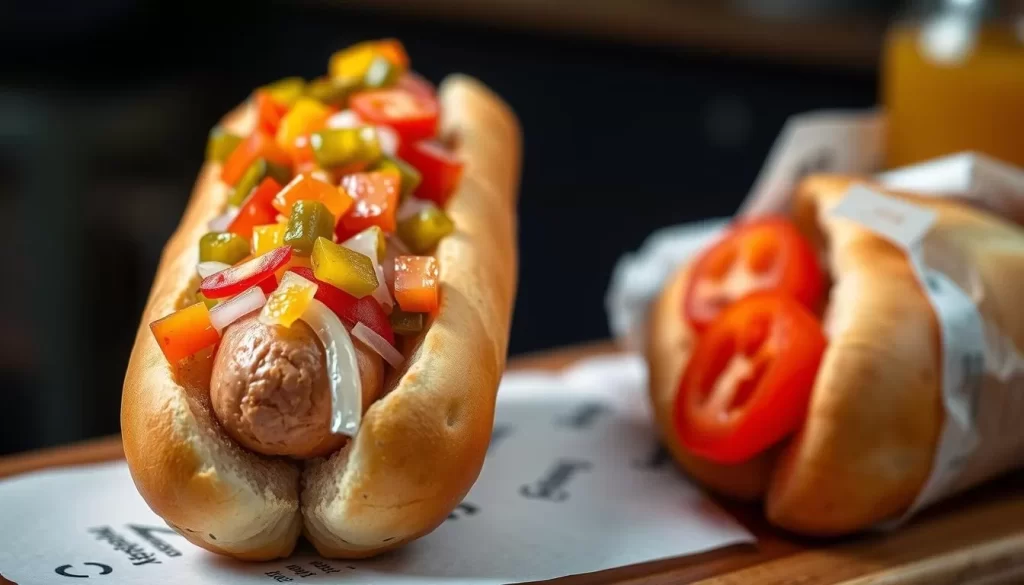
The Chicago-style hot dog is an iconic representation of the city’s gastronomic identity, with its distinctive toppings and preparation. This savory treat has gained a reputation for its tantalizing tastiness, making it a must-try when visiting Chicago.
What Makes a Chicago-Style Hot Dog Authentic
An authentic Chicago-style hot dog consists of seven essential components: an all-beef Vienna frank on a poppy seed bun, topped with yellow mustard, bright green relish, fresh chopped onions, tomato wedges, a pickle spear, peppers, and a dash of celery salt. The absence of ketchup is a defining characteristic, as it’s considered a culinary faux pas to include it.
The significance of these components lies not only in their individual flavors but also in how they come together to create a harmonious taste experience. The poppy seed bun adds a subtle texture, while the combination of toppings provides a balance of sweet, sour, and spicy flavors.
Superdawg Drive-In: A Chicago Legend
Superdawg Drive-In is a Chicago institution that has been serving hot dogs since 1948. This beloved eatery is known for its distinctive blue-boxed hot dogs and iconic 12-foot hot dog mascots that have watched over Milwaukee Avenue for generations. Superdawg’s commitment to quality and nostalgia has made it a staple in the Chicago food scene.
The Wieners Circle: Late-Night Hot Dog Haven
The Wieners Circle in Lincoln Park offers a unique late-night experience where the sharp-tongued staff are famous for their colorful banter with customers, making it as much about the entertainment as the excellent char-dogs. This restaurant is a go-to destination for those seeking a delicious hot dog and a lively atmosphere.
Gene & Jude’s: Home of the “Depression Dog”
Gene & Jude’s “Depression Dog” represents an alternative Chicago hot dog style, featuring a simpler presentation with just mustard, onions, relish, and peppers, served with hand-cut fries piled directly on top of the dog in the same wrapper. This variation showcases the diversity within Chicago’s hot dog culture.
Deep Dish Pizza: Chicago’s Iconic Contribution
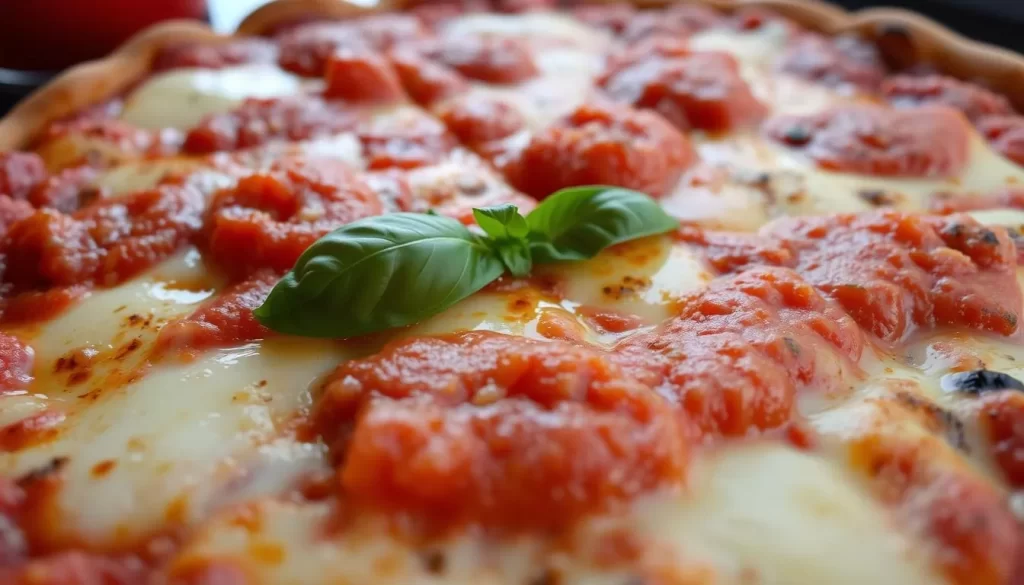
Chicago’s deep dish pizza is a culinary icon that has captured the hearts of food lovers everywhere. You’re about to embark on a journey through the history and highlights of this beloved dish.
The History of Chicago Deep Dish
The origins of deep dish pizza are traced back to 1943 at Pizzeria Uno, where Ike Sewell and Ric Riccardo created this hearty style. It reflected Chicago’s robust appetite and became an instant hit, despite breaking all the rules of traditional pizza.
Deep dish pizza is characterized by its thick, buttery crust that forms a deep “dish” filled with layers of cheese, toppings, and topped with tomato sauce. This fundamental difference from other pizza styles is what makes it so unique and satisfying.
Lou Malnati’s: Classic Deep Dish Experience
Lou Malnati’s has become synonymous with classic Chicago deep dish. Their butter crust recipe has remained unchanged for generations, and they use fresh California tomatoes exclusively for their signature tangy sauce. When you visit Lou Malnati’s, you’re experiencing a piece of Chicago’s culinary history.
Pequod’s Pizza: Caramelized Crust Perfection
Pequod’s Pizza offers a unique variation with its caramelized crust, created when cheese is placed between the dough and the pan, then baked until it forms a crispy, blackened edge. This textural contrast is a hallmark of Pequod’s and a favorite among deep dish enthusiasts.
George’s Deep Dish: New School Excellence
George’s Deep Dish in Edgewater represents the new generation of pizzamakers, where traditional techniques meet modern sensibilities. Their takeout-only operation often sells out of its meticulously crafted pies, showcasing the evolving yet timeless appeal of deep dish pizza.
As you explore these iconic establishments, you’ll discover why deep dish pizza remains a staple of Chicago’s food scene. Whether you’re a long-time fan or just discovering this culinary treasure, Chicago’s deep dish pizza is sure to leave a lasting impression.
Italian Beef Sandwiches: Chicago’s Juicy Delight
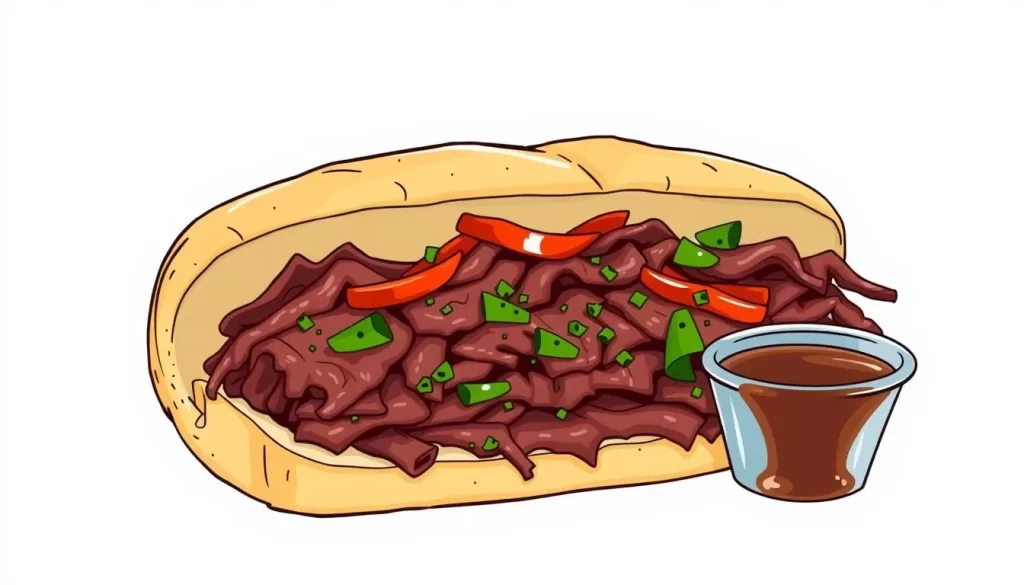
The Italian beef sandwich, a quintessential Chicago experience, is a must-try for any food enthusiast. This beloved dish has a rich history, rooted in the city’s Italian-American community.
The Origin Story
The Italian beef sandwich originated in Chicago’s Italian immigrant communities as a practical solution to stretch expensive beef by slicing it paper-thin and simmering it in a flavorful broth. This method created a delicious and filling meal that eventually became a staple of Chicago’s culinary scene.
The story goes that a street peddler named Anthony Ferrari created the Italian beef sandwich in the early 1900s to feed large wedding crowds. His son, Al, played a significant role in popularizing the dish, which is now a Chicago classic.
Al’s Beef: The Original Italian Beef
Al’s Beef, established in 1938, is renowned for its authentic Italian beef recipe. The perfectly seasoned beef and distinctive blend of spices in the cooking broth continue to attract long lines of customers.
At Al’s Beef, you can experience the original Italian beef sandwich that has been a Chicago favorite for generations. The restaurant’s commitment to traditional methods and flavors has made it a must-visit destination.
Portillo’s: Beloved Chicago Chain
Portillo’s represents how Italian beef has evolved from a neighborhood specialty to a Chicago institution. With multiple locations, Portillo’s serves consistent, high-quality Italian beef sandwiches alongside other Chicago classics.
Their Italian beef is a testament to the dish’s versatility and enduring popularity, making Portillo’s a go-to spot for both locals and tourists.
Mr. Beef: As Seen on “The Bear”
Mr. Beef on Orleans in River North is a no-frills eatery that gained national attention as the inspiration for the hit TV show “The Bear.” This small dive is big on flavor, serving some of the city’s best Italian beef.
The authentic Chicago atmosphere at Mr. Beef is as much a draw as their perfectly executed Italian beef sandwiches. It’s a must-visit for anyone looking to experience the real deal.
How to Order Your Italian Beef
When ordering an Italian beef sandwich, you’ll be asked if you want it “dry,” “wet,” or “dipped.” “Dry” means minimal gravy, “wet” means extra gravy, and “dipped” means the entire sandwich is briefly submerged in beef jus. You can also choose between “sweet” or “hot” peppers as a topping.
Understanding these terms will enhance your Italian beef experience, allowing you to customize your sandwich to your liking.
Maxwell Street Polish: A Chicago Original
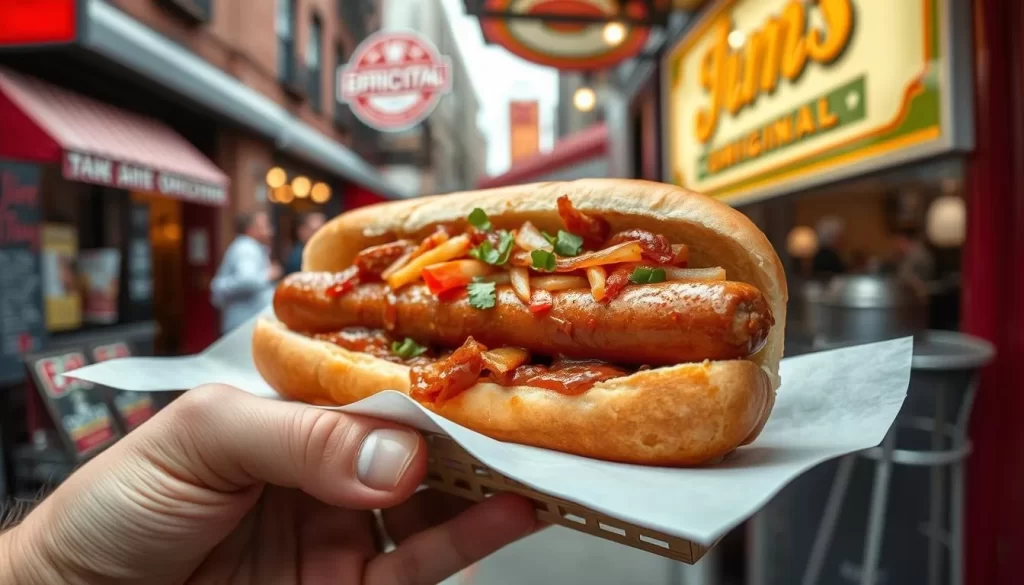
In the heart of Chicago, a legendary street food was born: the Maxwell Street Polish sausage, a flavorful delight that continues to captivate food enthusiasts. This iconic dish has a rich history tied to the city’s immigrant communities and the vibrant Maxwell Street Market.
The History of Maxwell Street Market
The Maxwell Street Market was once the bustling heart of Chicago’s immigrant community, where vendors created a distinctive style of street food that combined Polish culinary traditions with local innovations. The market’s history dates back to the late 19th century, and it played a significant role in shaping the city’s food culture.
As you explore the history of Maxwell Street, you’ll discover how this melting pot of cultures contributed to the creation of the Maxwell Street Polish sausage sandwich. The market’s vendors were instrumental in developing this beloved dish, which has become synonymous with Chicago’s street food scene.
Jim’s Original: Keeping Tradition Alive
Jim’s Original, established in 1939, claims to have invented the Maxwell Street Polish sausage sandwich and continues to serve the classic dish 24 hours a day from its location on Union Avenue. After being displaced from the original Maxwell Street, Jim’s has maintained its commitment to traditional recipes and cooking methods.
At Jim’s Original, you can experience the authentic taste of a Maxwell Street Polish sausage, made with a kielbasa-style sausage that’s split and grilled until charred, then topped with yellow mustard, a pile of caramelized onions, and optional sport peppers, all on a plain roll. This filling, flavorful, and affordable meal has been a Chicago staple since 1943.
Where to Find Authentic Polish Sausages Today
While the original Maxwell Street Market has undergone significant changes, including relocation and redevelopment, dedicated vendors have kept the tradition of the Maxwell Street Polish sausage alive. You can still find authentic Polish sausages at various locations throughout Chicago.
Some popular spots include Express Grill, a longtime rival of Jim’s Original, and newer establishments that honor the tradition while adding their own contemporary touches to this Chicago classic. Whether you’re a longtime Chicago resident or just visiting, be sure to try a Maxwell Street Polish sausage at one of these authentic eateries.
As you explore Chicago’s street food scene, you’ll discover that the Maxwell Street Polish sausage remains a beloved and integral part of the city’s culinary identity. Its enduring popularity is a testament to the power of food to bring people together and transcend cultural boundaries.
Chicago, Illinois: Where to Find the Best Street Food
From the spicy kick of Korean BBQ in Albany Park to the hearty Polish sausages in Avondale, Chicago’s street food is a journey worth taking. As you explore this vibrant city, you’ll discover that its culinary landscape is as diverse as it is delicious.
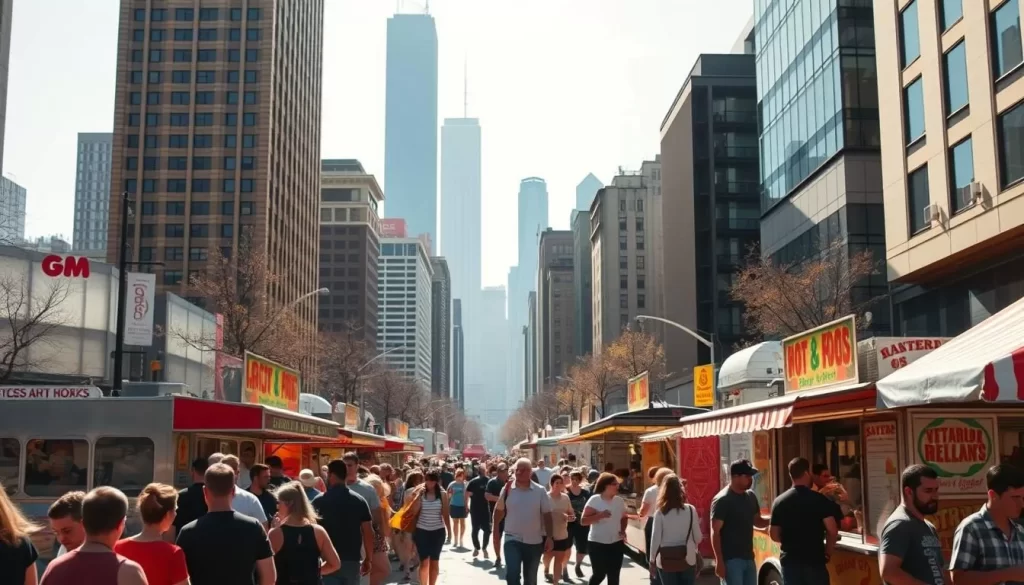
Navigating Chicago’s Diverse Food Neighborhoods
Chicago is home to 77 distinct neighborhoods, each with its own unique food specialties. To experience the best of Chicago’s street food, you need to know where to look. Let’s start with Pilsen, a hub for Mexican cuisine where you can find authentic tacos and other traditional dishes.
For Polish cuisine, head to Avondale, where you can sample hearty Polish sausages and other local favorites. If you’re in the mood for something different, Albany Park offers a variety of Korean dishes, including BBQ and kimchi.
| Neighborhood | Specialty | Must-Try Dish |
|---|---|---|
| Pilsen | Mexican | Tacos |
| Avondale | Polish | Polish Sausage |
| Albany Park | Korean | BBQ |
Seasonal Considerations for Street Food Hunting
Chicago’s extreme seasonal changes can significantly impact the availability of street food. During the summer, the city comes alive with food festivals and outdoor markets, such as the revived Maxwell Street Market on Sundays.
In contrast, winter drives many vendors indoors to food halls and permanent locations. This shift doesn’t mean the end of street food; it just means you need to know where to look. Some popular winter destinations include indoor markets and food courts.
Local Food Etiquette: Ordering Like a Chicagoan
Understanding local food etiquette can enhance your dining experience. When ordering at counter-service establishments, it’s essential to know what you want before reaching the front. This isn’t just about being efficient; it’s also a sign of respect for the staff and other customers.
When enjoying an Italian beef sandwich, adopt the “Italian stance” to avoid dripping. And, while it’s not a hard and fast rule, asking for ketchup on a hot dog might get you some playful ridicule from locals. Embracing these quirks can make your dining experience more enjoyable and authentic.
To spot authentic local establishments, look for places where locals line up, restaurants with focused menus, and establishments with old photos on the walls. These signs indicate a genuine, community-driven eatery rather than a tourist trap.
Sweet Treats: Chicago’s Dessert Street Food

Indulge in Chicago’s rich dessert culture, where every bite is a delight. Chicago’s street food scene isn’t just about savory delights; the city is also renowned for its sweet treats that are as Instagram-worthy as they are delicious. From classic ice cream cones to artisanal doughnuts, Chicago’s dessert scene is diverse and exciting.
You’ll discover a variety of iconic dessert spots throughout the city, each offering a unique taste experience. Whether you’re a local or just visiting, Chicago’s desserts are sure to satisfy your sweet tooth.
The Original Rainbow Cone: Colorful Chicago Classic
The Original Rainbow Cone is a Chicago institution since 1926, where the signature five-flavor cone stacks chocolate, strawberry, Palmer House (vanilla with cherries and walnuts), pistachio, and orange sherbet in a distinctive layered pattern that has become an Instagram favorite. Try the ultra-photogenic treat at Rainbow Cone’s original Beverly location or their Navy Pier outpost.
The Rainbow Cone’s commitment to quality and unique flavor combinations has made it a beloved dessert destination in Chicago.
Garrett Popcorn: Chicago’s Famous Caramel Crisp
Garrett Popcorn Shops created “Chicago Mix” (now called Garrett Mix for trademark reasons), the sweet-savory combination of caramel crisp and cheese popcorn that has people lining up at their downtown locations and has become a popular souvenir for visitors. This classic Chicago dessert first debuted at the inaugural Taste of Chicago, the nationally renowned food festival.
Garrett Popcorn’s commitment to using high-quality ingredients and traditional cooking methods has made their popcorn a staple in Chicago’s dessert scene.
Eli’s Cheesecake: A Chicago Institution
Eli’s Cheesecake began as a dessert at a steakhouse and grew into a Chicago institution that now produces over 20,000 cheesecakes daily, with their signature dessert becoming the official cheesecake of numerous Chicago festivals and events. At family-owned Eli’s Cheesecake, making cheesecake is an art that requires precision and dedication.
Their cheesecakes are renowned for their creamy texture and rich flavor, making them a must-try when visiting Chicago.
Doughnut Vault and Do-Rite: Doughnut Destinations
Chicago’s artisanal doughnut scene is highlighted by Doughnut Vault’s limited daily batches that create lines around the block, and Do-Rite’s chef-driven approach that includes both traditional and innovative flavors like candied maple bacon and pistachio-meyer lemon. These doughnut shops offer a unique and delicious dessert experience.
Whether you’re in the mood for something classic or adventurous, Chicago’s artisanal doughnut scene has something to satisfy your cravings.
Ethnic Street Food Enclaves in Chicago
The city’s vibrant street food scene is a reflection of its cultural diversity, with various ethnic enclaves offering a unique taste experience. As you explore Chicago, you’ll have the opportunity to sample flavors from around the world, all within the city’s diverse neighborhoods.
Pilsen: Mexican Street Food Paradise
Pilsen is Chicago’s vibrant Mexican neighborhood, where the street food traditions are alive and thriving. Places like 5 Rabanitos and Carnitas Uruapan, which has been slow-cooking whole pigs for perfect tacos since 1975, are must-visits. You can also explore traditional Mexican panaderías (bakeries) where you can select fresh-baked conchas, orejas, and other pastries using a tray and tongs, all for just a few dollars.
For taco enthusiasts, Taqueria El Milagro is a standout with its made-from-scratch tortillas. The variety of family-owned taquerias in Pilsen and nearby Little Village, Chicago’s hubs for Mexican American culture and cuisine, ensures that there’s always something new to try.
Devon Avenue: Indian and Pakistani Street Eats
Devon Avenue is Chicago’s Indian and Pakistani corridor, where the street food traditions from the subcontinent come alive. You’ll find chaat (savory snack) vendors, kebab shops, and sweet shops selling colorful mithai (desserts) like jalebi and gulab jamun. King Sweets is a highlight, showcasing a variety of South Asian desserts, including mango kulfi (un churned ice cream).
| Restaurant | Cuisine | Specialty |
|---|---|---|
| King Sweets | Indian/Pakistani | Mango Kulfi, Jalebi |
| Taqueria El Milagro | Mexican | Made-from-scratch Tortillas |
| Carnitas Uruapan | Mexican | Slow-cooked Pork Tacos |
Argyle Street: Vietnamese and Southeast Asian Delights
Argyle Street in Uptown is known as Chicago’s “Little Vietnam,” where you can find authentic bánh mì sandwiches, Vietnamese coffee, and pho shops alongside other Southeast Asian specialties. From Laotian papaya salad to Thai boat noodles, the flavors on Argyle Street are a testament to the diversity of Chicago’s culinary landscape.
Exploring these ethnic enclaves not only offers a culinary adventure but also a glimpse into the cultural richness of Chicago. Whether you’re in the mood for Mexican, Indian, Pakistani, Vietnamese, or other Southeast Asian cuisine, Chicago’s street food scene has something to satisfy every craving.
Chicago Food Trucks: Mobile Culinary Innovators
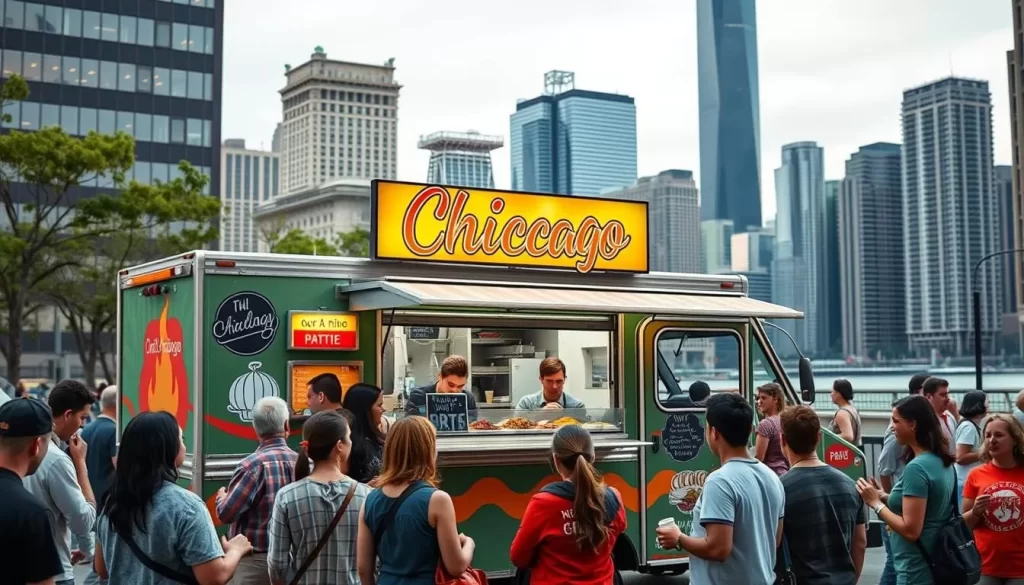
The mobile culinary innovators of Chicago are redefining the city’s street food culture. Chicago’s food trucks have become an integral part of the culinary landscape, offering a diverse range of options that cater to various tastes and preferences.
Navigating Chicago’s Food Truck Scene
To navigate Chicago’s food truck scene, you can use social media and apps like the Chicago Food Truck Finder. This allows you to track the daily locations and schedules of food trucks, which can change based on events, weather, and customer demand.
Chicago has unique regulations for food trucks, including a rule that prohibits them from parking within 200 feet of a brick-and-mortar restaurant selling similar food. This has led to the creation of designated food truck “stands” throughout the city.
The Fat Shallot: Gourmet Sandwiches on Wheels
The Fat Shallot is a prime example of a successful food truck that started with “big, bomb sandwiches” and has since expanded to a restaurant in Lincoln Park. They offer a gourmet twist on classic sandwiches, such as truffle BLTs and crispy buffalo chicken, alongside burgers, wraps, shakes, and Belgian fries.
5411 Empanadas: Argentine Hand Pies
5411 Empanadas, named after Argentina’s international dialing code, has introduced many Chicagoans to authentic Argentine hand pies through their food truck. They have since expanded to multiple storefronts across the city, offering a variety of empanadas that showcase Argentine cuisine.
Where to Find Food Truck Gatherings
Chicago hosts various food truck gatherings, including weekly lunch meetups at Daley Plaza and the University of Chicago. Seasonal food truck festivals are also a highlight, where dozens of vendors gather, making it easy to sample multiple options in one visit.
These gatherings not only offer a wide range of food options but also contribute to the vibrant street food culture of Chicago, making it a great place to experience the city’s culinary diversity.
Jibaritos and Puerto Rican Flavors

Chicago’s culinary scene is enriched by the jibarito, a sandwich that reflects the city’s vibrant Puerto Rican heritage. You might be wondering what a jibarito is. Simply put, it’s a sandwich made with sliced and fried plantains instead of bread, filled with your choice of protein, and generously adorned with lettuce, mayo, and cheese.
The Chicago Origin of the Jibarito Sandwich
The jibarito, pronounced hee-bah-REE-to, is a Chicago original, invented in 1996 at the now-closed Borinquen Restaurant in Humboldt Park. This innovative sandwich was created as a way to serve traditional Puerto Rican flavors in a new format. The jibarito is constructed with twice-fried, flattened green plantains replacing bread, garlic mayo, cheese, lettuce, tomato, and your choice of protein, creating a crunchy, savory sandwich experience unique to Chicago.
Humboldt Park: Puerto Rican Food Hub
Humboldt Park is the heart of Chicago’s Puerto Rican community, marked by the 59-foot steel Puerto Rican flags that arch over Division Street. Here, you can find not just jibaritos but other Puerto Rican specialties like mofongo, arroz con gandules, and pasteles. The area is a hub of mouth-watering Puerto Rican street food, with jibaritos being a standout. Food trucks in the area also serve various Puerto Rican dishes, including Lechon, a type of roast pork, and morcilla, a blood sausage.
Best Spots for Authentic Jibaritos
If you’re looking for the best jibaritos in Chicago, there are several places you should try. Papa’s Cache Sabroso in Humboldt Park is known for its garlicky marinade on their pork jibarito, making it a neighborhood favorite. Another great spot is Jibaritos y Más, which offers over a dozen variations of the sandwich, giving you plenty of options to taste and explore. You can also visit La Bomba in Logan Square or Marina’s Bistro in Uptown for a delicious jibarito experience.
When you visit these places, you’ll experience the rich flavors of Puerto Rico in the heart of Chicago. The jibarito is more than just a sandwich; it’s a reflection of the city’s cultural diversity and culinary creativity. So, take the time to explore Humboldt Park and enjoy the street food scene, including the iconic jibarito.
Chicago Barbecue: Street Food with Smoke
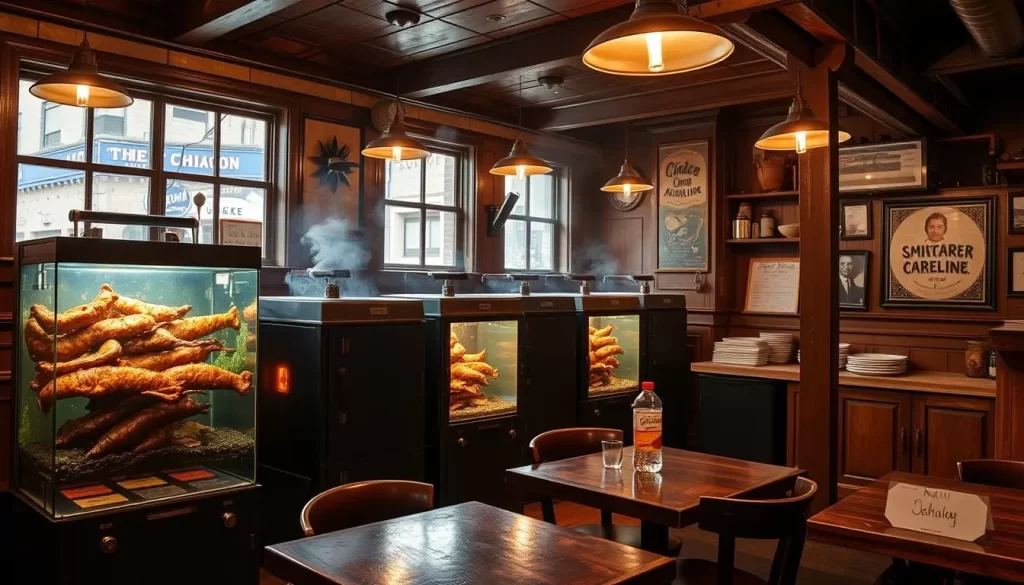
Chicago’s barbecue scene is a culinary gem that shines bright with its unique style and rich heritage. When exploring the city’s street food, you can’t miss the smoky flavors and tantalizing aromas of Chicago-style barbecue.
The Unique Style of Chicago BBQ
Chicago’s barbecue style is distinct from other regional traditions, characterized by its use of aquarium smokers, rib tips, hot links, and sauce-forward preparations. This style reflects the city’s South Side African American culinary heritage.
The aquarium smokers, with their glass-fronted, rectangular design, are a hallmark of Chicago barbecue. They allow pitmasters to slow-cook meat to perfection, infusing it with a deep, smoky flavor.
Lem’s Bar-B-Q: South Side Institution
Lem’s Bar-B-Q has been serving up classic Chicago-style barbecue since 1954, making it one of the oldest Black-owned barbecue establishments in the city. Their aquarium smoker produces quintessential Chicago-style rib tips and hot links that locals love.
Smoque BBQ: Award-Winning Barbecue
Smoque BBQ in Irving Park has brought competition-style barbecue techniques to Chicago, earning national recognition for their meticulously smoked brisket, pulled pork, and St. Louis ribs. They balance Chicago traditions with Texas and Carolina influences, offering a unique barbecue experience.
Lexington Betty Smokehouse: New School BBQ
Lexington Betty Smokehouse is a newer establishment that combines traditional smoking techniques with contemporary presentations. Pitmaster Dominique Leach’s innovative approach shows how Chicago’s barbecue scene continues to evolve while honoring its heritage.
Chicago’s barbecue culture is not just about the food; it’s also about the community and the people who make it happen. From traditional joints like Lem’s to modern innovators like Lexington Betty Smokehouse, there’s a wealth of barbecue experiences to explore in the city.
When you’re in Chicago, be sure to try some of the city’s famous rib tips, hot links, and other barbecue delights. Whether you’re a local or just visiting, Chicago’s barbecue scene is sure to leave you wanting more.
Logan Square and Wicker Park Food Scene
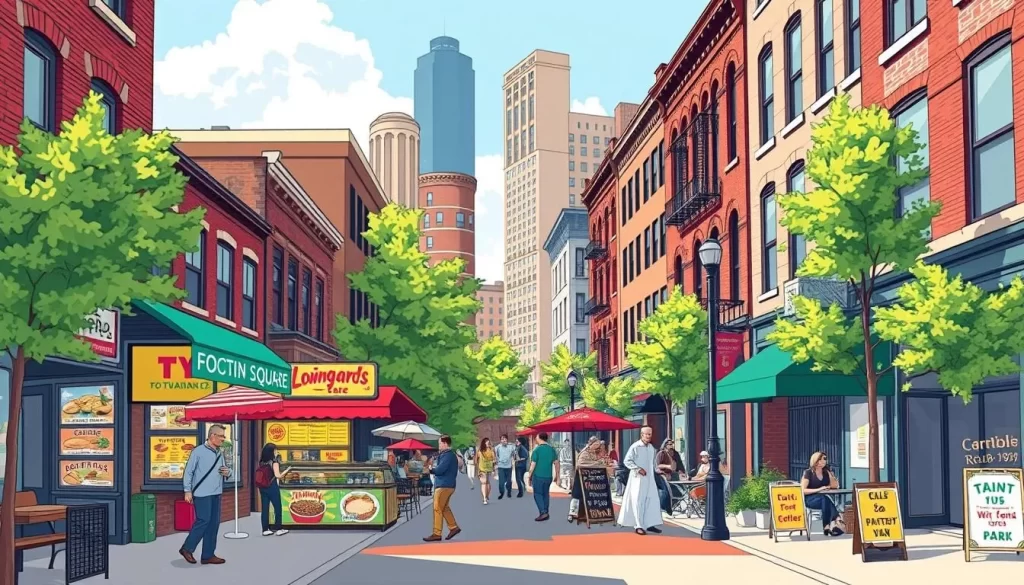
As you explore Chicago’s vibrant food landscape, Logan Square and Wicker Park stand out as culinary hotspots. These adjacent neighborhoods have evolved into a foodie’s paradise, offering a diverse range of culinary experiences that blend traditional flavors with innovative twists.
Lula Cafe: Farm-to-Table Pioneer
Lula Cafe, owned by chef Jason Hammel, has been a pioneer in Logan Square since 1999. It has evolved from a simple breakfast spot to a farm-to-table institution that has launched numerous culinary careers. The restaurant’s commitment to using locally sourced ingredients has set a high standard for the neighborhood.
Jason Hammel’s dedication to farm-to-table cuisine has not only elevated the dining experience at Lula Cafe but has also influenced the broader food scene in Logan Square and beyond.
Pretty Cool Ice Cream: Creative Frozen Treats
Pretty Cool Ice Cream, founded by Dana Cree, is a Logan Square institution that specializes in hand-held frozen treats on sticks. With flavors ranging from classic vanilla bean to experimental combinations like peanut butter potato chip, this ice cream shop is a must-visit for anyone looking to try something new.
Miko’s Italian Ice: Seasonal Refreshment
Miko’s Italian Ice is a seasonal Logan Square favorite that opens during the warmer months. Serving dairy-free frozen treats in a variety of flavors such as mango, watermelon, and their signature lemon, Miko’s creates a buzz among locals on hot summer days.
Wicker Park’s Street Food Innovations
Wicker Park’s food scene is evolving, with traditional taquerias and Polish delis now sharing the neighborhood with innovative concepts. Places like Mindy’s Bakery, from James Beard Award-winning pastry chef Mindy Segal, and Cebu, which serves Filipino street food, are redefining the culinary landscape.
The blend of old and new in Wicker Park offers visitors a unique culinary experience, showcasing the neighborhood’s ability to adapt and innovate while respecting its heritage.
Seasonal Street Food Events in Chicago
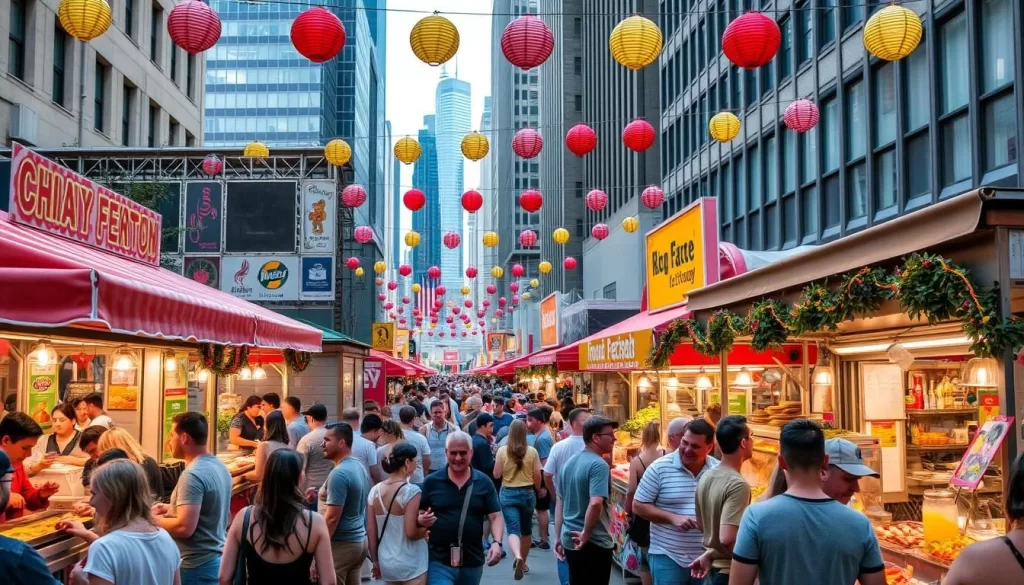
As the seasons change, Chicago transforms into a culinary playground with a variety of street food events that cater to all tastes. The city’s food scene is not just about the restaurants and street food vendors; it’s also about the vibrant festivals that bring the community together. In this section, we’ll explore some of the most notable seasonal street food events in Chicago.
Taste of Chicago: The Ultimate Food Festival
The Taste of Chicago is the nation’s largest food festival, attracting over a million visitors each year. Held in Grant Park, this iconic event brings together over 70 restaurants serving sample-sized portions of their signature dishes. The festival has evolved over the years, now including pop-up neighborhood events throughout the summer, making it easier to sample Chicago’s diverse food scene without the downtown crowds.
You can expect a wide range of food options at the Taste of Chicago, from classic Chicago-style hot dogs and deep dish pizza to international cuisine. The event also features live music and summer fun, making it a must-visit for anyone looking to experience the best of Chicago’s street food.
Chicago Gourmet: Upscale Street Food Experience
For a more upscale street food experience, Chicago Gourmet is the place to be. Held in Millennium Park each September, this festival features renowned chefs offering sophisticated street food interpretations alongside cooking demonstrations, wine tastings, and themed pavilions. It’s an opportunity to taste the best of Chicago’s culinary scene in an elegant setting.
Chicago Gourmet showcases the city’s restaurant scene, with a focus on local ingredients and innovative cuisine. Whether you’re a foodie or just looking for a unique dining experience, Chicago Gourmet is an event not to be missed.
Neighborhood Food Festivals Worth Visiting
Beyond the major festivals, Chicago’s neighborhoods host their own food festivals, each with its unique charm. Events like Ribfest Chicago in North Center, Pilsen’s Mole de Mayo celebration, the Argyle Night Market in Uptown, and the Green City Market BBQ offer a chance to experience the diversity of Chicago’s food scene. These events feature local chefs cooking with sustainable ingredients and offer a more intimate setting to enjoy street food.
To make the most of Chicago’s food festivals, consider tips such as purchasing tickets in advance for popular events, pacing yourself to try a variety of dishes, and exploring different neighborhoods to discover new flavors. With so many food options available, you’re sure to find something that suits your taste.
Unique Chicago Creations: Beyond the Classics
From Italian-American innovations to unique pizza styles, Chicago’s culinary landscape is dotted with one-of-a-kind dishes that are sure to tantalize your taste buds. As you explore the city’s food scene, you’ll discover a variety of flavors and specialties that reflect Chicago’s diverse cultural influences and practical, working-class roots.
Chicken Vesuvio: Italian-American Innovation
Chicken Vesuvio is a dish that exists almost exclusively in Chicago, featuring bone-in chicken and potato wedges roasted with white wine, garlic, and herbs. This Italian-American classic is a staple in many Chicago restaurants, with Harry Caray’s Italian Steakhouse being a top recommendation for the best Chicken Vesuvio in the city. The dish is characterized by its crispy outside, juicy inside chicken, and flavorful potatoes that absorb the rich sauce. You can experience this culinary delight by ordering it at one of the many local eateries that serve this beloved dish.
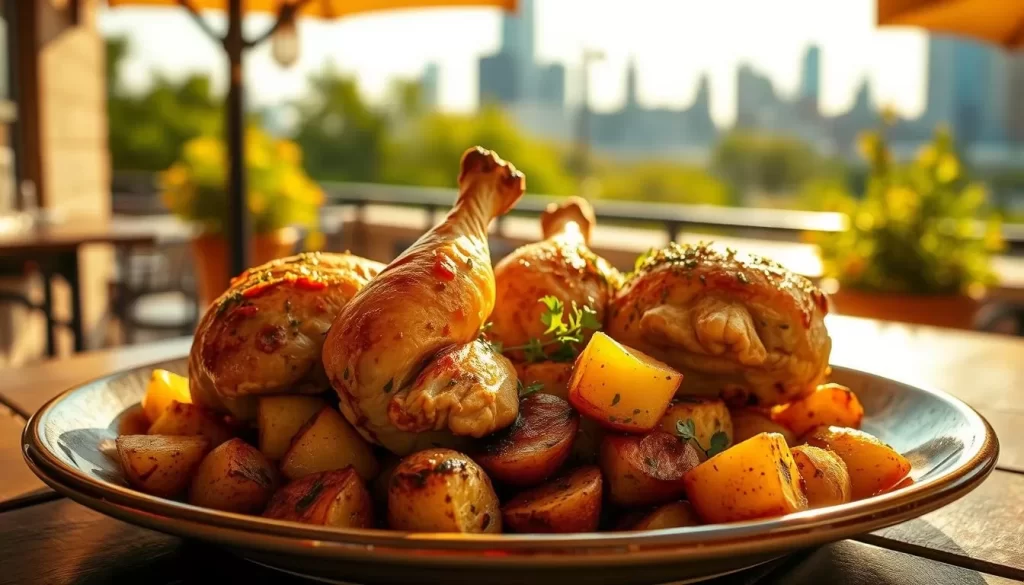
The Original Brownie: Born at the Palmer House
The brownie, a beloved dessert worldwide, has its roots in Chicago. It was created at the Palmer House Hotel for the 1893 World’s Columbian Exposition. Bertha Palmer, a socialite, requested a portable chocolate dessert for ladies attending the fair, resulting in the first recognized brownie recipe. To this day, the Palmer House Hotel continues to use the same century-old recipe, offering visitors a chance to taste the original brownie at the hotel. You can indulge in this historic dessert and experience a piece of Chicago’s culinary history.
Tavern-Style Pizza: Chicago’s “Other” Pizza
Chicago is known for more than one style of pizza. While deep-dish pizza is famous nationwide, locals actually eat more tavern-style pizza, also known as “party cut” pizza. This style features a thin, crispy crust topped with ingredients edge to edge, cut into small squares, and is designed to be an inexpensive bar snack. Classic toppings include fennel-heavy sausage, green pepper, and onion. Vito & Nick’s Pizza on the South Side is a renowned spot for this style, offering a delicious and authentic tavern-style pizza experience. You can enjoy this Chicago staple at various local taverns and pizzerias throughout the city.
In addition to these well-known creations, Chicago is also home to other unique dishes like the Jim Shoe sandwich and the mother-in-law sandwich. The Jim Shoe, found primarily on the South Side, is a hearty combination of roast beef, gyro meat, and corned beef topped with giardiniera. The mother-in-law sandwich, originating from the Maxwell Street area, consists of a tamale on a hot dog bun topped with chili. These lesser-known specialties showcase the city’s diverse cultural influences and its history of creating practical, flavorful food for the working class.
- Discover Chicken Vesuvio, a Chicago staple featuring roasted chicken and potatoes in a flavorful sauce.
- Learn about the origins of the brownie, created at the Palmer House Hotel for the 1893 World’s Columbian Exposition.
- Experience tavern-style pizza, a beloved local favorite with a thin, crispy crust and edge-to-edge toppings.
- Explore other unique Chicago creations, such as the Jim Shoe and mother-in-law sandwiches, reflecting the city’s diverse cultural heritage.
Budget-Friendly Street Food Options
You don’t have to spend a fortune to experience the best of Chicago’s street food. The city offers a wide range of affordable options that cater to diverse tastes and preferences.
Maxwell Street Market: Sunday Food Adventure
The revived Maxwell Street Market, now held on Sundays on Desplaines Street, is a treasure trove of affordable and authentic street food. Here, you can find delicious Mexican dishes such as quesadillas made with hand-pressed blue corn tortillas, huaraches, and elotes. This market is a testament to Chicago’s culinary diversity and its ability to offer great food at reasonable prices.
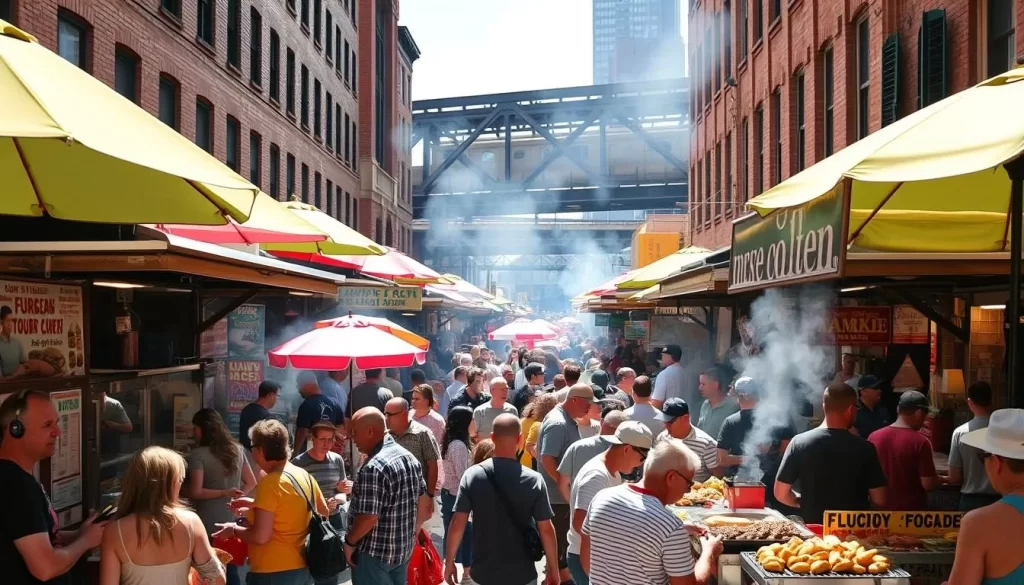
At Maxwell Street Market, you can enjoy a satisfying meal without breaking the bank. The market’s vibrant atmosphere and variety of food options make it an ideal destination for those looking to experience the best of Chicago’s street food culture.
Mario’s Italian Lemonade: Seasonal Treat
Mario’s Italian Lemonade is a beloved seasonal stand that has been a part of Chicago’s Little Italy neighborhood since 1954. During the warmer months, this family-run shop opens on bustling Taylor Street, offering refreshing flavored ice in a variety of flavors such as lemon, watermelon, and cantaloupe. For just a few dollars, you can enjoy a cool treat that is sure to satisfy your sweet tooth.
The long lines of devoted fans that form during Chicago’s warm months are a testament to Mario’s Italian Lemonade’s popularity and the quality of its products.
Student-Friendly Street Food Spots
Chicago’s universities are surrounded by a variety of budget-friendly street food options. Near Loyola University, the diverse and affordable international restaurants along Argyle Street offer a range of cuisines to suit every taste. Similarly, near the University of Illinois at Chicago (UIC), food trucks gather to provide a convenient and affordable dining option for students.
In Lincoln Park, around DePaul University, you’ll find late-night options that cater to students looking for a quick and affordable meal. These areas are perfect for students and budget-conscious foodies alike.
| Street Food | Price | Location |
|---|---|---|
| Depression Dog at Red Hot Ranch | $5 | Multiple Locations |
| Tacos at Carnitas Uruapan | $3-$5 | Pilsen Neighborhood |
| Jibaritos at Papa’s Cache Sabroso | $8 | Humboldt Park |
| Tavern-Style Pizza at Pat’s Pizza | $3-$5 per slice | Multiple Locations |
Chicago’s street food scene is not just about the food; it’s also about the experience. Even in typically expensive areas like Navy Pier and the Loop, you can find affordable options. At Navy Pier, enjoy a Rainbow Cone ice cream, while in the Loop, grab a Chicago-style hot dog from a street vendor for half the price of sit-down restaurants.
By exploring these budget-friendly options, you can enjoy the best of Chicago’s street food without overspending. Whether you’re a local or just visiting, Chicago’s diverse culinary landscape has something to offer everyone.
Conclusion: Embracing Chicago’s Street Food Culture
As you conclude your culinary journey through Chicago, it’s clear that the city’s street food scene is a vibrant reflection of its diverse cultural heritage. Chicago has earned a reputation as one of the nation’s top culinary capitals, and its street food is a significant contributor to this status.
The city’s rich history and immigrant roots have shaped its culinary landscape, making it a melting pot of flavors and cuisines. From the iconic Chicago-style hot dog to the lesser-known treasures like jibaritos and tavern-style pizza, there’s a wealth of culinary experiences waiting to be discovered.
As you’ve explored the various neighborhoods of Chicago, you’ve likely noticed that each area offers its unique flavors and specialties. Whether you’re drawn to the smoky rib tips of the South Side, the vibrant Mexican street food of Pilsen, or the creative ice cream innovations of Logan Square, Chicago’s street food scene has something for every palate.
To truly experience the best of Chicago’s street food, remember to follow the locals, venture beyond downtown, and be willing to try unfamiliar dishes. The city’s culinary landscape continues to evolve while honoring its traditions, making it a dynamic and exciting place to explore.
Whether you’re visiting Navy Pier, Lincoln Park, or any of the city’s 77 unique neighborhoods, you’ll find that Chicago’s street food is more than just a meal – it’s an experience. It’s about the cultural context and community spirit that surrounds it, from the shared experience of standing in line for a hot dog with strangers to the multi-generational family businesses that have perfected their recipes over decades.
As you plan your future culinary adventures, consider adding Chicago to your list of must-visit destinations. With its rich food culture, diverse neighborhoods, and welcoming atmosphere, Chicago is sure to leave a lasting impression on your taste buds.
The above is subject to change.
Check back often to TRAVEL.COM for the latest travel tips and deals.
